Analyzing Drug Abuse: Causes, Theories, Prevalence, and Interventions
VerifiedAdded on 2022/12/26
|14
|4169
|1
Essay
AI Summary
This essay provides a comprehensive analysis of drug abuse, delving into the multifaceted reasons behind substance use, the prevalence rates of addiction, and the various theoretical frameworks used to understand it. The paper explores the initial choices individuals make to consume drugs, the biological, environmental, and social factors that contribute to addiction, and the complex nature of addiction as a chronic disease. It examines the prevalence of substance abuse across different age groups, including the rising rates among older adults. Furthermore, the essay discusses key theories of addiction, such as negative reinforcement, positive reinforcement, incentive salience, stimulus-response learning, and inhibitory control dysfunction. It also explores the relationship between drug use and crime, examining causal mechanisms and highlighting the correlation between violent behavior and drug use, including the vicious cycle between crime, addiction, and poverty.
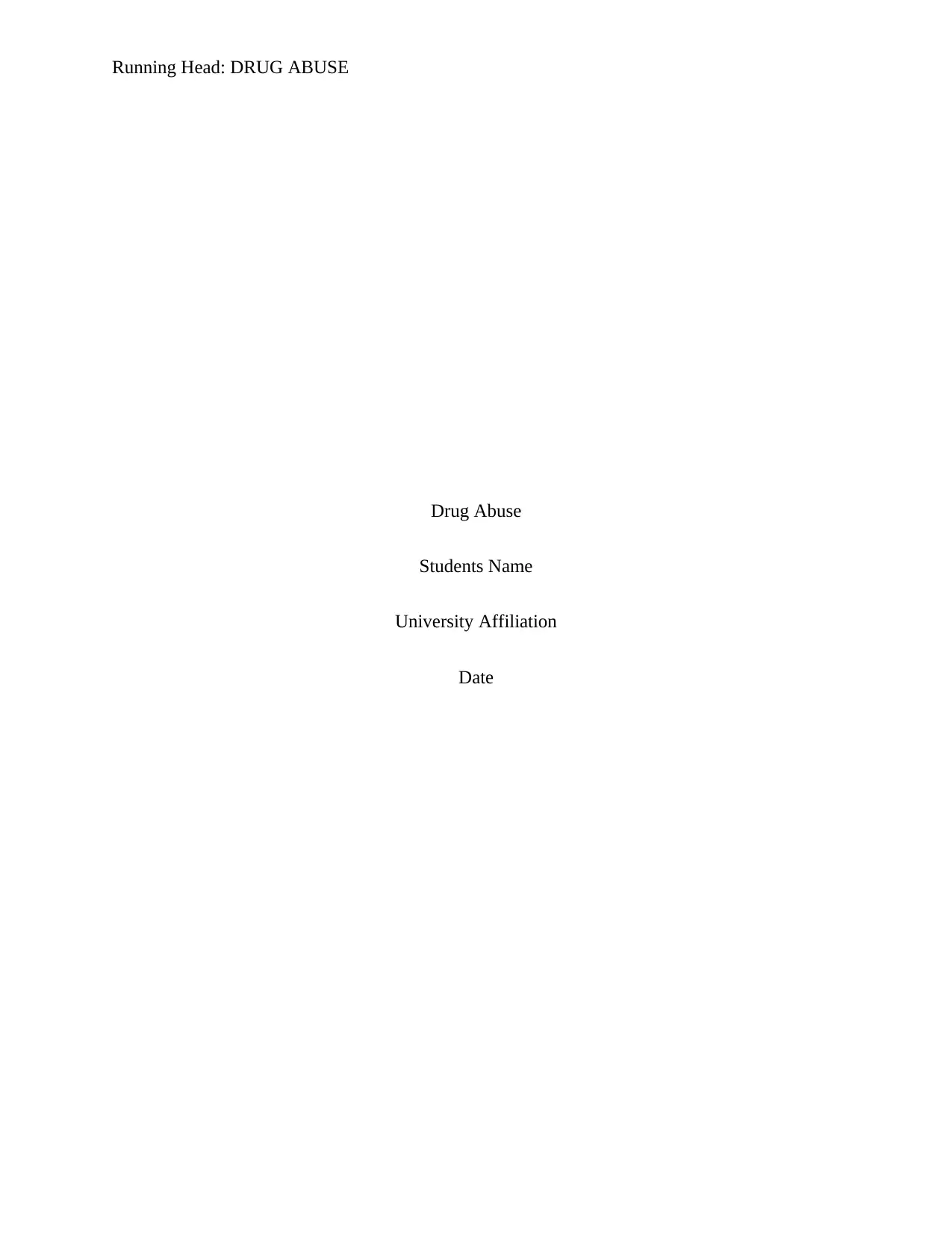
Running Head: DRUG ABUSE
Drug Abuse
Students Name
University Affiliation
Date
Drug Abuse
Students Name
University Affiliation
Date
Paraphrase This Document
Need a fresh take? Get an instant paraphrase of this document with our AI Paraphraser
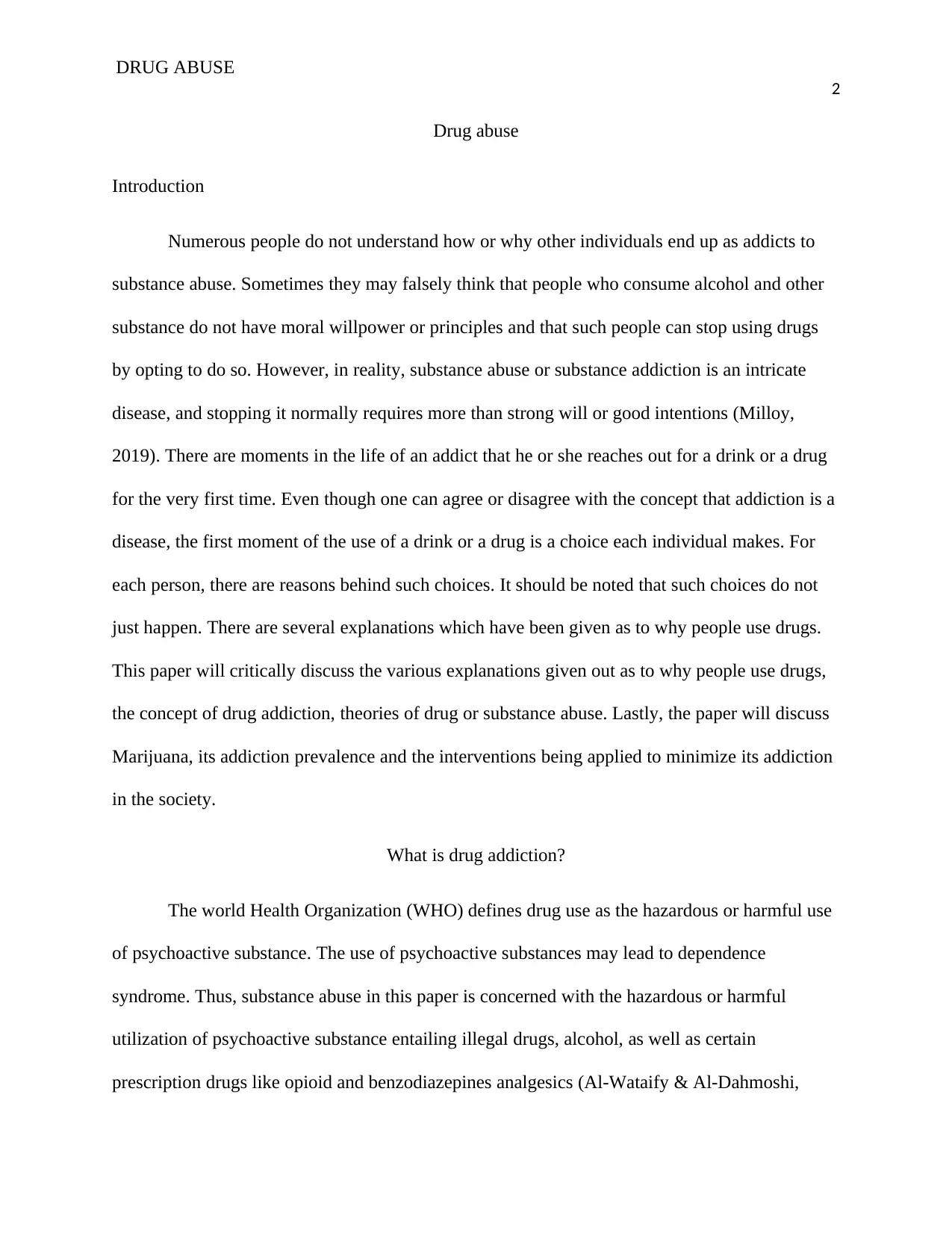
DRUG ABUSE
2
Drug abuse
Introduction
Numerous people do not understand how or why other individuals end up as addicts to
substance abuse. Sometimes they may falsely think that people who consume alcohol and other
substance do not have moral willpower or principles and that such people can stop using drugs
by opting to do so. However, in reality, substance abuse or substance addiction is an intricate
disease, and stopping it normally requires more than strong will or good intentions (Milloy,
2019). There are moments in the life of an addict that he or she reaches out for a drink or a drug
for the very first time. Even though one can agree or disagree with the concept that addiction is a
disease, the first moment of the use of a drink or a drug is a choice each individual makes. For
each person, there are reasons behind such choices. It should be noted that such choices do not
just happen. There are several explanations which have been given as to why people use drugs.
This paper will critically discuss the various explanations given out as to why people use drugs,
the concept of drug addiction, theories of drug or substance abuse. Lastly, the paper will discuss
Marijuana, its addiction prevalence and the interventions being applied to minimize its addiction
in the society.
What is drug addiction?
The world Health Organization (WHO) defines drug use as the hazardous or harmful use
of psychoactive substance. The use of psychoactive substances may lead to dependence
syndrome. Thus, substance abuse in this paper is concerned with the hazardous or harmful
utilization of psychoactive substance entailing illegal drugs, alcohol, as well as certain
prescription drugs like opioid and benzodiazepines analgesics (Al-Wataify & Al-Dahmoshi,
2
Drug abuse
Introduction
Numerous people do not understand how or why other individuals end up as addicts to
substance abuse. Sometimes they may falsely think that people who consume alcohol and other
substance do not have moral willpower or principles and that such people can stop using drugs
by opting to do so. However, in reality, substance abuse or substance addiction is an intricate
disease, and stopping it normally requires more than strong will or good intentions (Milloy,
2019). There are moments in the life of an addict that he or she reaches out for a drink or a drug
for the very first time. Even though one can agree or disagree with the concept that addiction is a
disease, the first moment of the use of a drink or a drug is a choice each individual makes. For
each person, there are reasons behind such choices. It should be noted that such choices do not
just happen. There are several explanations which have been given as to why people use drugs.
This paper will critically discuss the various explanations given out as to why people use drugs,
the concept of drug addiction, theories of drug or substance abuse. Lastly, the paper will discuss
Marijuana, its addiction prevalence and the interventions being applied to minimize its addiction
in the society.
What is drug addiction?
The world Health Organization (WHO) defines drug use as the hazardous or harmful use
of psychoactive substance. The use of psychoactive substances may lead to dependence
syndrome. Thus, substance abuse in this paper is concerned with the hazardous or harmful
utilization of psychoactive substance entailing illegal drugs, alcohol, as well as certain
prescription drugs like opioid and benzodiazepines analgesics (Al-Wataify & Al-Dahmoshi,
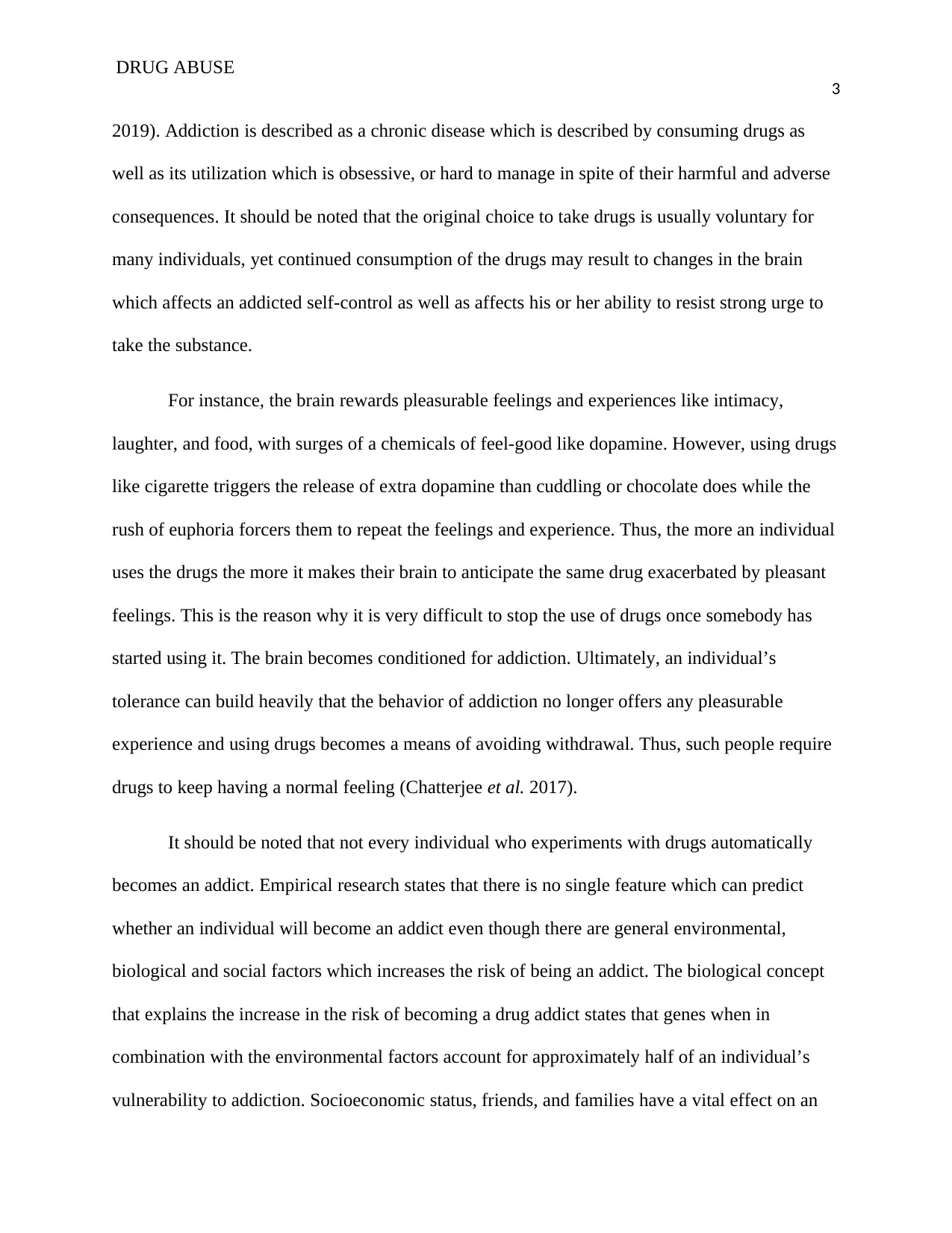
DRUG ABUSE
3
2019). Addiction is described as a chronic disease which is described by consuming drugs as
well as its utilization which is obsessive, or hard to manage in spite of their harmful and adverse
consequences. It should be noted that the original choice to take drugs is usually voluntary for
many individuals, yet continued consumption of the drugs may result to changes in the brain
which affects an addicted self-control as well as affects his or her ability to resist strong urge to
take the substance.
For instance, the brain rewards pleasurable feelings and experiences like intimacy,
laughter, and food, with surges of a chemicals of feel-good like dopamine. However, using drugs
like cigarette triggers the release of extra dopamine than cuddling or chocolate does while the
rush of euphoria forcers them to repeat the feelings and experience. Thus, the more an individual
uses the drugs the more it makes their brain to anticipate the same drug exacerbated by pleasant
feelings. This is the reason why it is very difficult to stop the use of drugs once somebody has
started using it. The brain becomes conditioned for addiction. Ultimately, an individual’s
tolerance can build heavily that the behavior of addiction no longer offers any pleasurable
experience and using drugs becomes a means of avoiding withdrawal. Thus, such people require
drugs to keep having a normal feeling (Chatterjee et al. 2017).
It should be noted that not every individual who experiments with drugs automatically
becomes an addict. Empirical research states that there is no single feature which can predict
whether an individual will become an addict even though there are general environmental,
biological and social factors which increases the risk of being an addict. The biological concept
that explains the increase in the risk of becoming a drug addict states that genes when in
combination with the environmental factors account for approximately half of an individual’s
vulnerability to addiction. Socioeconomic status, friends, and families have a vital effect on an
3
2019). Addiction is described as a chronic disease which is described by consuming drugs as
well as its utilization which is obsessive, or hard to manage in spite of their harmful and adverse
consequences. It should be noted that the original choice to take drugs is usually voluntary for
many individuals, yet continued consumption of the drugs may result to changes in the brain
which affects an addicted self-control as well as affects his or her ability to resist strong urge to
take the substance.
For instance, the brain rewards pleasurable feelings and experiences like intimacy,
laughter, and food, with surges of a chemicals of feel-good like dopamine. However, using drugs
like cigarette triggers the release of extra dopamine than cuddling or chocolate does while the
rush of euphoria forcers them to repeat the feelings and experience. Thus, the more an individual
uses the drugs the more it makes their brain to anticipate the same drug exacerbated by pleasant
feelings. This is the reason why it is very difficult to stop the use of drugs once somebody has
started using it. The brain becomes conditioned for addiction. Ultimately, an individual’s
tolerance can build heavily that the behavior of addiction no longer offers any pleasurable
experience and using drugs becomes a means of avoiding withdrawal. Thus, such people require
drugs to keep having a normal feeling (Chatterjee et al. 2017).
It should be noted that not every individual who experiments with drugs automatically
becomes an addict. Empirical research states that there is no single feature which can predict
whether an individual will become an addict even though there are general environmental,
biological and social factors which increases the risk of being an addict. The biological concept
that explains the increase in the risk of becoming a drug addict states that genes when in
combination with the environmental factors account for approximately half of an individual’s
vulnerability to addiction. Socioeconomic status, friends, and families have a vital effect on an
⊘ This is a preview!⊘
Do you want full access?
Subscribe today to unlock all pages.

Trusted by 1+ million students worldwide
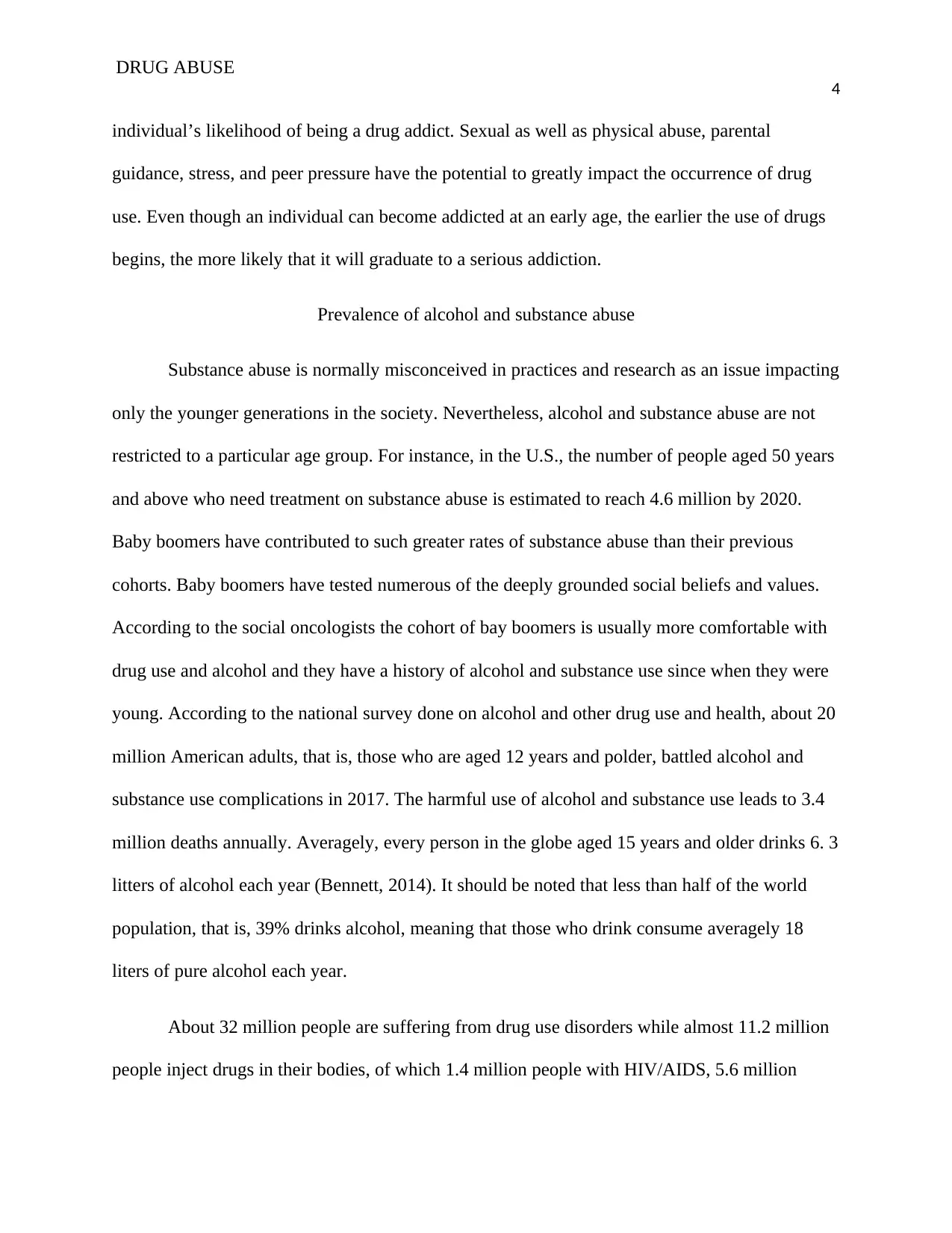
DRUG ABUSE
4
individual’s likelihood of being a drug addict. Sexual as well as physical abuse, parental
guidance, stress, and peer pressure have the potential to greatly impact the occurrence of drug
use. Even though an individual can become addicted at an early age, the earlier the use of drugs
begins, the more likely that it will graduate to a serious addiction.
Prevalence of alcohol and substance abuse
Substance abuse is normally misconceived in practices and research as an issue impacting
only the younger generations in the society. Nevertheless, alcohol and substance abuse are not
restricted to a particular age group. For instance, in the U.S., the number of people aged 50 years
and above who need treatment on substance abuse is estimated to reach 4.6 million by 2020.
Baby boomers have contributed to such greater rates of substance abuse than their previous
cohorts. Baby boomers have tested numerous of the deeply grounded social beliefs and values.
According to the social oncologists the cohort of bay boomers is usually more comfortable with
drug use and alcohol and they have a history of alcohol and substance use since when they were
young. According to the national survey done on alcohol and other drug use and health, about 20
million American adults, that is, those who are aged 12 years and polder, battled alcohol and
substance use complications in 2017. The harmful use of alcohol and substance use leads to 3.4
million deaths annually. Averagely, every person in the globe aged 15 years and older drinks 6. 3
litters of alcohol each year (Bennett, 2014). It should be noted that less than half of the world
population, that is, 39% drinks alcohol, meaning that those who drink consume averagely 18
liters of pure alcohol each year.
About 32 million people are suffering from drug use disorders while almost 11.2 million
people inject drugs in their bodies, of which 1.4 million people with HIV/AIDS, 5.6 million
4
individual’s likelihood of being a drug addict. Sexual as well as physical abuse, parental
guidance, stress, and peer pressure have the potential to greatly impact the occurrence of drug
use. Even though an individual can become addicted at an early age, the earlier the use of drugs
begins, the more likely that it will graduate to a serious addiction.
Prevalence of alcohol and substance abuse
Substance abuse is normally misconceived in practices and research as an issue impacting
only the younger generations in the society. Nevertheless, alcohol and substance abuse are not
restricted to a particular age group. For instance, in the U.S., the number of people aged 50 years
and above who need treatment on substance abuse is estimated to reach 4.6 million by 2020.
Baby boomers have contributed to such greater rates of substance abuse than their previous
cohorts. Baby boomers have tested numerous of the deeply grounded social beliefs and values.
According to the social oncologists the cohort of bay boomers is usually more comfortable with
drug use and alcohol and they have a history of alcohol and substance use since when they were
young. According to the national survey done on alcohol and other drug use and health, about 20
million American adults, that is, those who are aged 12 years and polder, battled alcohol and
substance use complications in 2017. The harmful use of alcohol and substance use leads to 3.4
million deaths annually. Averagely, every person in the globe aged 15 years and older drinks 6. 3
litters of alcohol each year (Bennett, 2014). It should be noted that less than half of the world
population, that is, 39% drinks alcohol, meaning that those who drink consume averagely 18
liters of pure alcohol each year.
About 32 million people are suffering from drug use disorders while almost 11.2 million
people inject drugs in their bodies, of which 1.4 million people with HIV/AIDS, 5.6 million
Paraphrase This Document
Need a fresh take? Get an instant paraphrase of this document with our AI Paraphraser
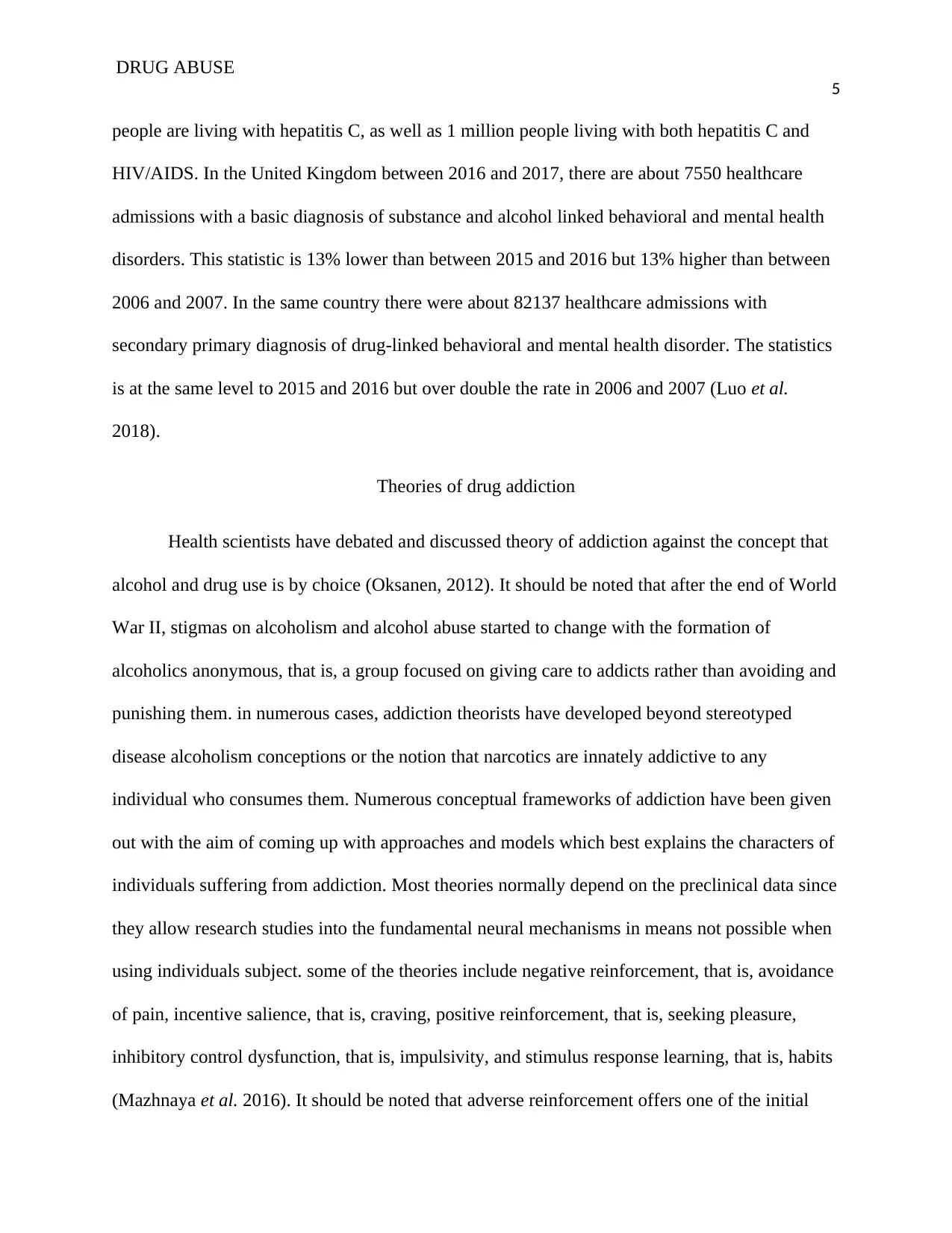
DRUG ABUSE
5
people are living with hepatitis C, as well as 1 million people living with both hepatitis C and
HIV/AIDS. In the United Kingdom between 2016 and 2017, there are about 7550 healthcare
admissions with a basic diagnosis of substance and alcohol linked behavioral and mental health
disorders. This statistic is 13% lower than between 2015 and 2016 but 13% higher than between
2006 and 2007. In the same country there were about 82137 healthcare admissions with
secondary primary diagnosis of drug-linked behavioral and mental health disorder. The statistics
is at the same level to 2015 and 2016 but over double the rate in 2006 and 2007 (Luo et al.
2018).
Theories of drug addiction
Health scientists have debated and discussed theory of addiction against the concept that
alcohol and drug use is by choice (Oksanen, 2012). It should be noted that after the end of World
War II, stigmas on alcoholism and alcohol abuse started to change with the formation of
alcoholics anonymous, that is, a group focused on giving care to addicts rather than avoiding and
punishing them. in numerous cases, addiction theorists have developed beyond stereotyped
disease alcoholism conceptions or the notion that narcotics are innately addictive to any
individual who consumes them. Numerous conceptual frameworks of addiction have been given
out with the aim of coming up with approaches and models which best explains the characters of
individuals suffering from addiction. Most theories normally depend on the preclinical data since
they allow research studies into the fundamental neural mechanisms in means not possible when
using individuals subject. some of the theories include negative reinforcement, that is, avoidance
of pain, incentive salience, that is, craving, positive reinforcement, that is, seeking pleasure,
inhibitory control dysfunction, that is, impulsivity, and stimulus response learning, that is, habits
(Mazhnaya et al. 2016). It should be noted that adverse reinforcement offers one of the initial
5
people are living with hepatitis C, as well as 1 million people living with both hepatitis C and
HIV/AIDS. In the United Kingdom between 2016 and 2017, there are about 7550 healthcare
admissions with a basic diagnosis of substance and alcohol linked behavioral and mental health
disorders. This statistic is 13% lower than between 2015 and 2016 but 13% higher than between
2006 and 2007. In the same country there were about 82137 healthcare admissions with
secondary primary diagnosis of drug-linked behavioral and mental health disorder. The statistics
is at the same level to 2015 and 2016 but over double the rate in 2006 and 2007 (Luo et al.
2018).
Theories of drug addiction
Health scientists have debated and discussed theory of addiction against the concept that
alcohol and drug use is by choice (Oksanen, 2012). It should be noted that after the end of World
War II, stigmas on alcoholism and alcohol abuse started to change with the formation of
alcoholics anonymous, that is, a group focused on giving care to addicts rather than avoiding and
punishing them. in numerous cases, addiction theorists have developed beyond stereotyped
disease alcoholism conceptions or the notion that narcotics are innately addictive to any
individual who consumes them. Numerous conceptual frameworks of addiction have been given
out with the aim of coming up with approaches and models which best explains the characters of
individuals suffering from addiction. Most theories normally depend on the preclinical data since
they allow research studies into the fundamental neural mechanisms in means not possible when
using individuals subject. some of the theories include negative reinforcement, that is, avoidance
of pain, incentive salience, that is, craving, positive reinforcement, that is, seeking pleasure,
inhibitory control dysfunction, that is, impulsivity, and stimulus response learning, that is, habits
(Mazhnaya et al. 2016). It should be noted that adverse reinforcement offers one of the initial
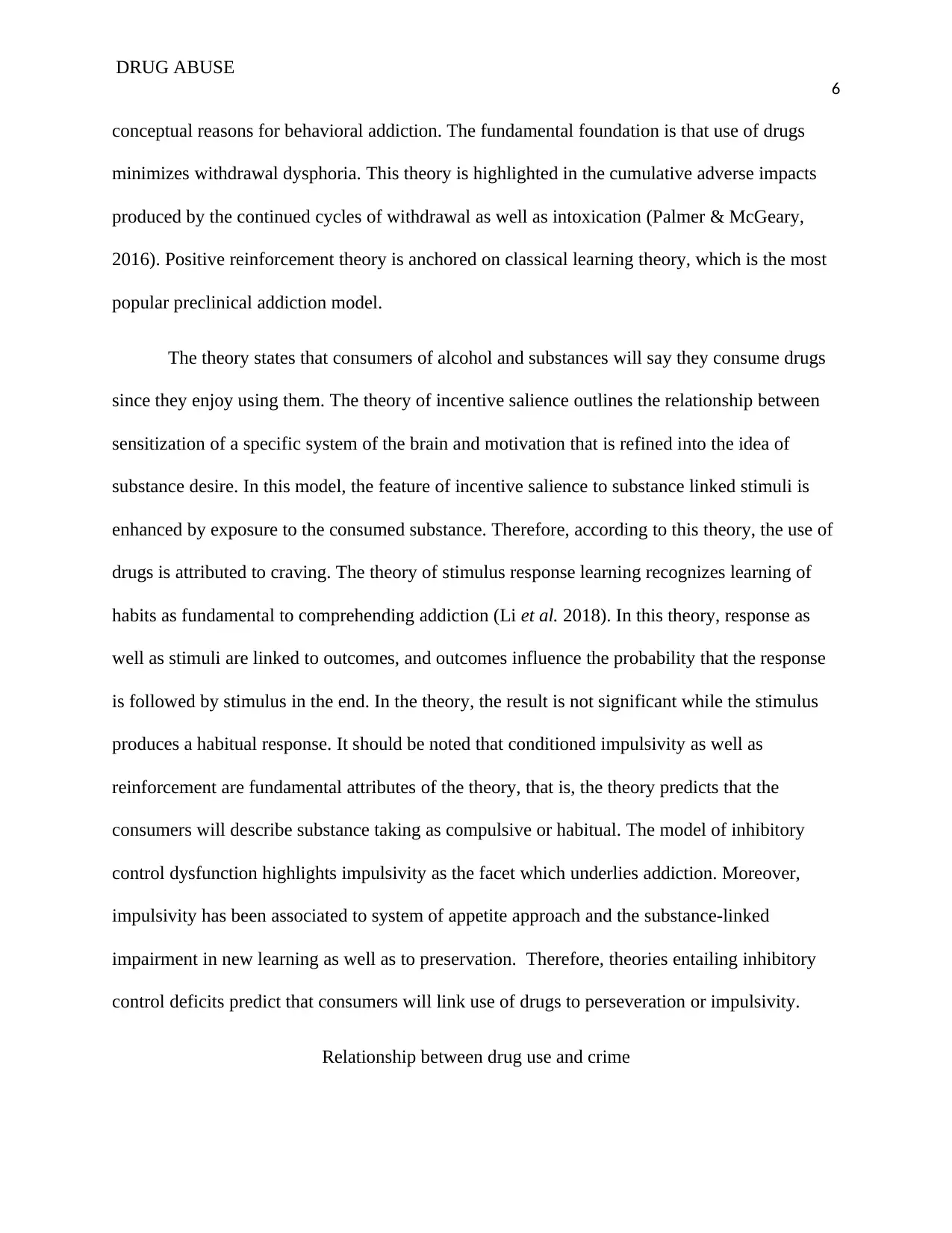
DRUG ABUSE
6
conceptual reasons for behavioral addiction. The fundamental foundation is that use of drugs
minimizes withdrawal dysphoria. This theory is highlighted in the cumulative adverse impacts
produced by the continued cycles of withdrawal as well as intoxication (Palmer & McGeary,
2016). Positive reinforcement theory is anchored on classical learning theory, which is the most
popular preclinical addiction model.
The theory states that consumers of alcohol and substances will say they consume drugs
since they enjoy using them. The theory of incentive salience outlines the relationship between
sensitization of a specific system of the brain and motivation that is refined into the idea of
substance desire. In this model, the feature of incentive salience to substance linked stimuli is
enhanced by exposure to the consumed substance. Therefore, according to this theory, the use of
drugs is attributed to craving. The theory of stimulus response learning recognizes learning of
habits as fundamental to comprehending addiction (Li et al. 2018). In this theory, response as
well as stimuli are linked to outcomes, and outcomes influence the probability that the response
is followed by stimulus in the end. In the theory, the result is not significant while the stimulus
produces a habitual response. It should be noted that conditioned impulsivity as well as
reinforcement are fundamental attributes of the theory, that is, the theory predicts that the
consumers will describe substance taking as compulsive or habitual. The model of inhibitory
control dysfunction highlights impulsivity as the facet which underlies addiction. Moreover,
impulsivity has been associated to system of appetite approach and the substance-linked
impairment in new learning as well as to preservation. Therefore, theories entailing inhibitory
control deficits predict that consumers will link use of drugs to perseveration or impulsivity.
Relationship between drug use and crime
6
conceptual reasons for behavioral addiction. The fundamental foundation is that use of drugs
minimizes withdrawal dysphoria. This theory is highlighted in the cumulative adverse impacts
produced by the continued cycles of withdrawal as well as intoxication (Palmer & McGeary,
2016). Positive reinforcement theory is anchored on classical learning theory, which is the most
popular preclinical addiction model.
The theory states that consumers of alcohol and substances will say they consume drugs
since they enjoy using them. The theory of incentive salience outlines the relationship between
sensitization of a specific system of the brain and motivation that is refined into the idea of
substance desire. In this model, the feature of incentive salience to substance linked stimuli is
enhanced by exposure to the consumed substance. Therefore, according to this theory, the use of
drugs is attributed to craving. The theory of stimulus response learning recognizes learning of
habits as fundamental to comprehending addiction (Li et al. 2018). In this theory, response as
well as stimuli are linked to outcomes, and outcomes influence the probability that the response
is followed by stimulus in the end. In the theory, the result is not significant while the stimulus
produces a habitual response. It should be noted that conditioned impulsivity as well as
reinforcement are fundamental attributes of the theory, that is, the theory predicts that the
consumers will describe substance taking as compulsive or habitual. The model of inhibitory
control dysfunction highlights impulsivity as the facet which underlies addiction. Moreover,
impulsivity has been associated to system of appetite approach and the substance-linked
impairment in new learning as well as to preservation. Therefore, theories entailing inhibitory
control deficits predict that consumers will link use of drugs to perseveration or impulsivity.
Relationship between drug use and crime
⊘ This is a preview!⊘
Do you want full access?
Subscribe today to unlock all pages.

Trusted by 1+ million students worldwide
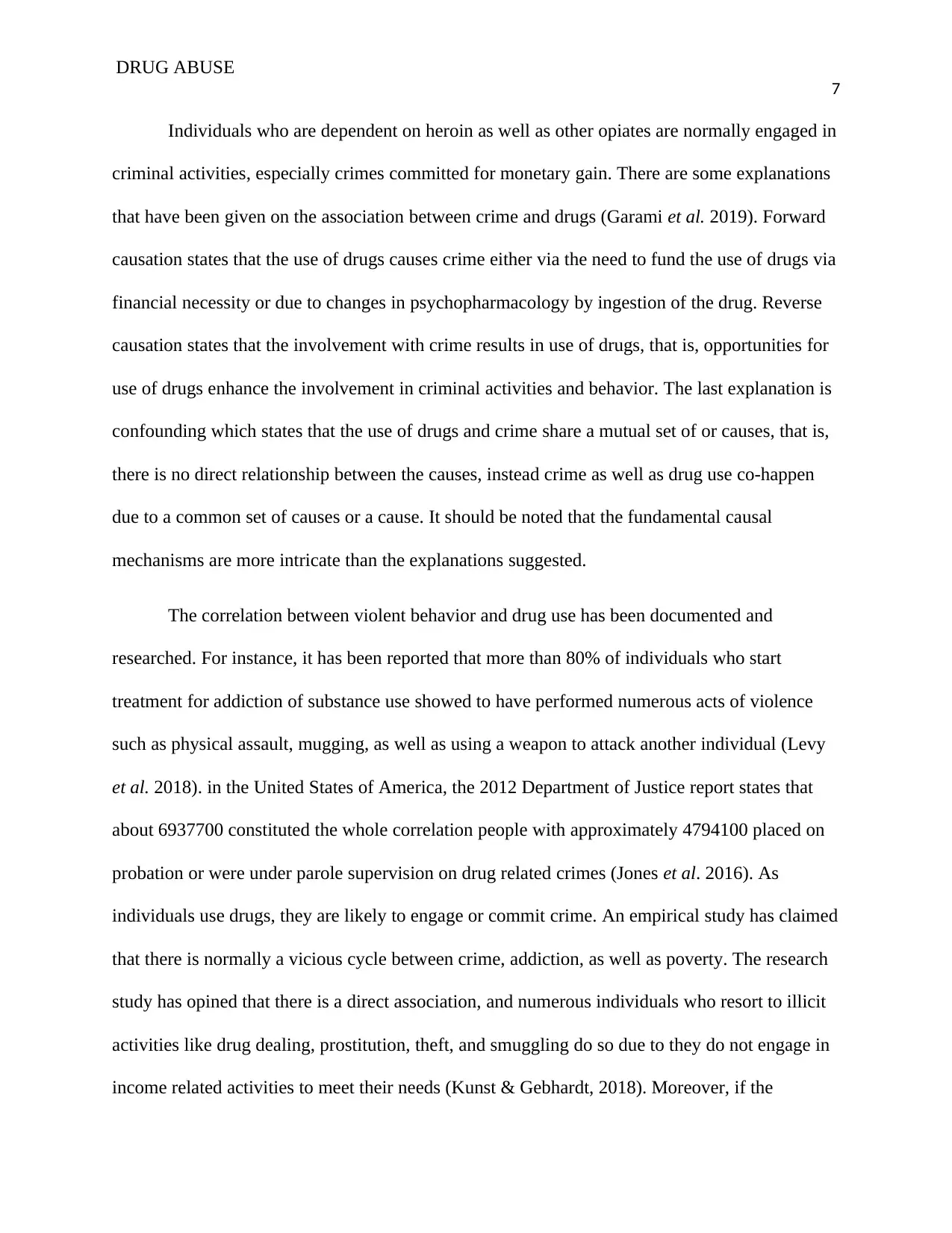
DRUG ABUSE
7
Individuals who are dependent on heroin as well as other opiates are normally engaged in
criminal activities, especially crimes committed for monetary gain. There are some explanations
that have been given on the association between crime and drugs (Garami et al. 2019). Forward
causation states that the use of drugs causes crime either via the need to fund the use of drugs via
financial necessity or due to changes in psychopharmacology by ingestion of the drug. Reverse
causation states that the involvement with crime results in use of drugs, that is, opportunities for
use of drugs enhance the involvement in criminal activities and behavior. The last explanation is
confounding which states that the use of drugs and crime share a mutual set of or causes, that is,
there is no direct relationship between the causes, instead crime as well as drug use co-happen
due to a common set of causes or a cause. It should be noted that the fundamental causal
mechanisms are more intricate than the explanations suggested.
The correlation between violent behavior and drug use has been documented and
researched. For instance, it has been reported that more than 80% of individuals who start
treatment for addiction of substance use showed to have performed numerous acts of violence
such as physical assault, mugging, as well as using a weapon to attack another individual (Levy
et al. 2018). in the United States of America, the 2012 Department of Justice report states that
about 6937700 constituted the whole correlation people with approximately 4794100 placed on
probation or were under parole supervision on drug related crimes (Jones et al. 2016). As
individuals use drugs, they are likely to engage or commit crime. An empirical study has claimed
that there is normally a vicious cycle between crime, addiction, as well as poverty. The research
study has opined that there is a direct association, and numerous individuals who resort to illicit
activities like drug dealing, prostitution, theft, and smuggling do so due to they do not engage in
income related activities to meet their needs (Kunst & Gebhardt, 2018). Moreover, if the
7
Individuals who are dependent on heroin as well as other opiates are normally engaged in
criminal activities, especially crimes committed for monetary gain. There are some explanations
that have been given on the association between crime and drugs (Garami et al. 2019). Forward
causation states that the use of drugs causes crime either via the need to fund the use of drugs via
financial necessity or due to changes in psychopharmacology by ingestion of the drug. Reverse
causation states that the involvement with crime results in use of drugs, that is, opportunities for
use of drugs enhance the involvement in criminal activities and behavior. The last explanation is
confounding which states that the use of drugs and crime share a mutual set of or causes, that is,
there is no direct relationship between the causes, instead crime as well as drug use co-happen
due to a common set of causes or a cause. It should be noted that the fundamental causal
mechanisms are more intricate than the explanations suggested.
The correlation between violent behavior and drug use has been documented and
researched. For instance, it has been reported that more than 80% of individuals who start
treatment for addiction of substance use showed to have performed numerous acts of violence
such as physical assault, mugging, as well as using a weapon to attack another individual (Levy
et al. 2018). in the United States of America, the 2012 Department of Justice report states that
about 6937700 constituted the whole correlation people with approximately 4794100 placed on
probation or were under parole supervision on drug related crimes (Jones et al. 2016). As
individuals use drugs, they are likely to engage or commit crime. An empirical study has claimed
that there is normally a vicious cycle between crime, addiction, as well as poverty. The research
study has opined that there is a direct association, and numerous individuals who resort to illicit
activities like drug dealing, prostitution, theft, and smuggling do so due to they do not engage in
income related activities to meet their needs (Kunst & Gebhardt, 2018). Moreover, if the
Paraphrase This Document
Need a fresh take? Get an instant paraphrase of this document with our AI Paraphraser
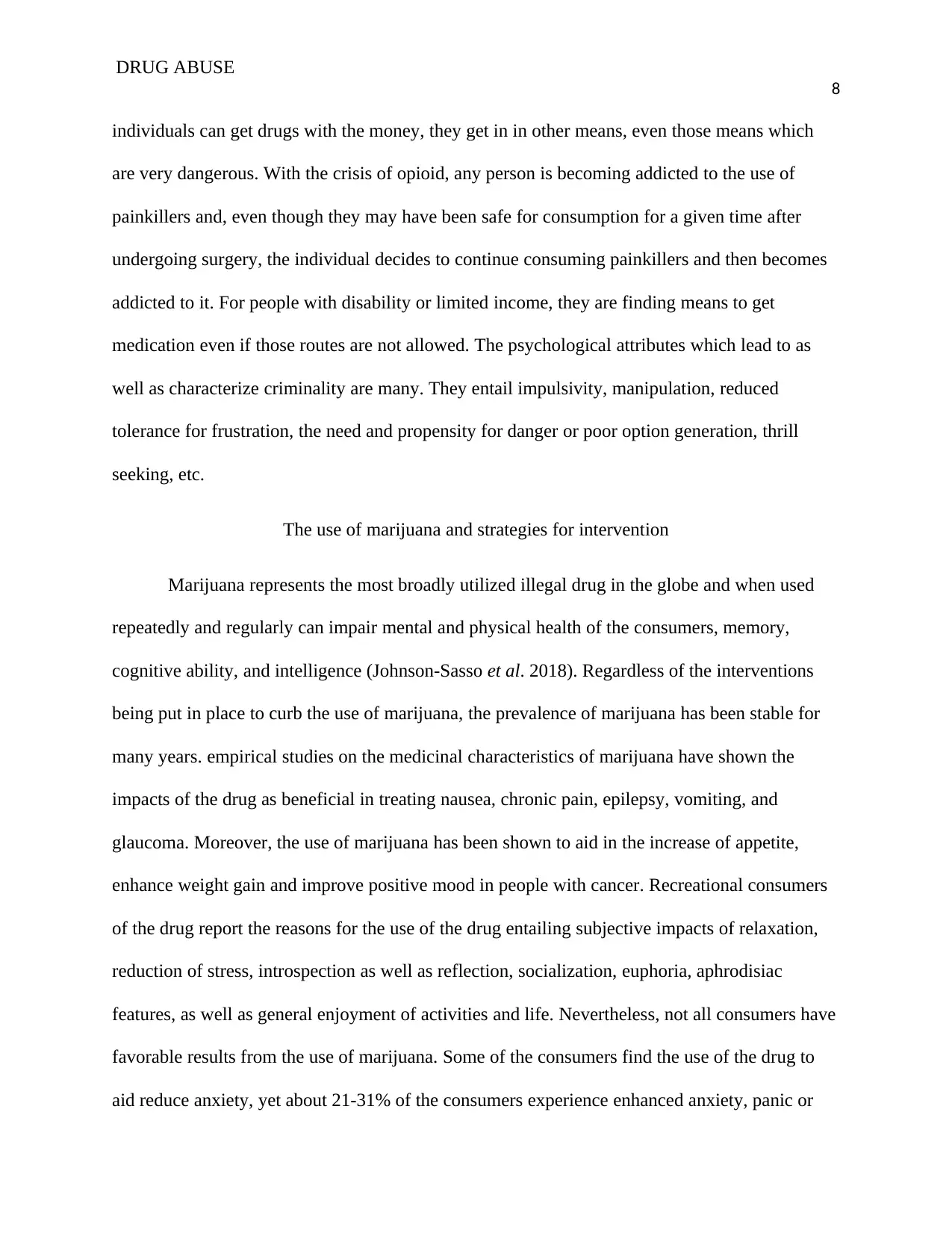
DRUG ABUSE
8
individuals can get drugs with the money, they get in in other means, even those means which
are very dangerous. With the crisis of opioid, any person is becoming addicted to the use of
painkillers and, even though they may have been safe for consumption for a given time after
undergoing surgery, the individual decides to continue consuming painkillers and then becomes
addicted to it. For people with disability or limited income, they are finding means to get
medication even if those routes are not allowed. The psychological attributes which lead to as
well as characterize criminality are many. They entail impulsivity, manipulation, reduced
tolerance for frustration, the need and propensity for danger or poor option generation, thrill
seeking, etc.
The use of marijuana and strategies for intervention
Marijuana represents the most broadly utilized illegal drug in the globe and when used
repeatedly and regularly can impair mental and physical health of the consumers, memory,
cognitive ability, and intelligence (Johnson-Sasso et al. 2018). Regardless of the interventions
being put in place to curb the use of marijuana, the prevalence of marijuana has been stable for
many years. empirical studies on the medicinal characteristics of marijuana have shown the
impacts of the drug as beneficial in treating nausea, chronic pain, epilepsy, vomiting, and
glaucoma. Moreover, the use of marijuana has been shown to aid in the increase of appetite,
enhance weight gain and improve positive mood in people with cancer. Recreational consumers
of the drug report the reasons for the use of the drug entailing subjective impacts of relaxation,
reduction of stress, introspection as well as reflection, socialization, euphoria, aphrodisiac
features, as well as general enjoyment of activities and life. Nevertheless, not all consumers have
favorable results from the use of marijuana. Some of the consumers find the use of the drug to
aid reduce anxiety, yet about 21-31% of the consumers experience enhanced anxiety, panic or
8
individuals can get drugs with the money, they get in in other means, even those means which
are very dangerous. With the crisis of opioid, any person is becoming addicted to the use of
painkillers and, even though they may have been safe for consumption for a given time after
undergoing surgery, the individual decides to continue consuming painkillers and then becomes
addicted to it. For people with disability or limited income, they are finding means to get
medication even if those routes are not allowed. The psychological attributes which lead to as
well as characterize criminality are many. They entail impulsivity, manipulation, reduced
tolerance for frustration, the need and propensity for danger or poor option generation, thrill
seeking, etc.
The use of marijuana and strategies for intervention
Marijuana represents the most broadly utilized illegal drug in the globe and when used
repeatedly and regularly can impair mental and physical health of the consumers, memory,
cognitive ability, and intelligence (Johnson-Sasso et al. 2018). Regardless of the interventions
being put in place to curb the use of marijuana, the prevalence of marijuana has been stable for
many years. empirical studies on the medicinal characteristics of marijuana have shown the
impacts of the drug as beneficial in treating nausea, chronic pain, epilepsy, vomiting, and
glaucoma. Moreover, the use of marijuana has been shown to aid in the increase of appetite,
enhance weight gain and improve positive mood in people with cancer. Recreational consumers
of the drug report the reasons for the use of the drug entailing subjective impacts of relaxation,
reduction of stress, introspection as well as reflection, socialization, euphoria, aphrodisiac
features, as well as general enjoyment of activities and life. Nevertheless, not all consumers have
favorable results from the use of marijuana. Some of the consumers find the use of the drug to
aid reduce anxiety, yet about 21-31% of the consumers experience enhanced anxiety, panic or
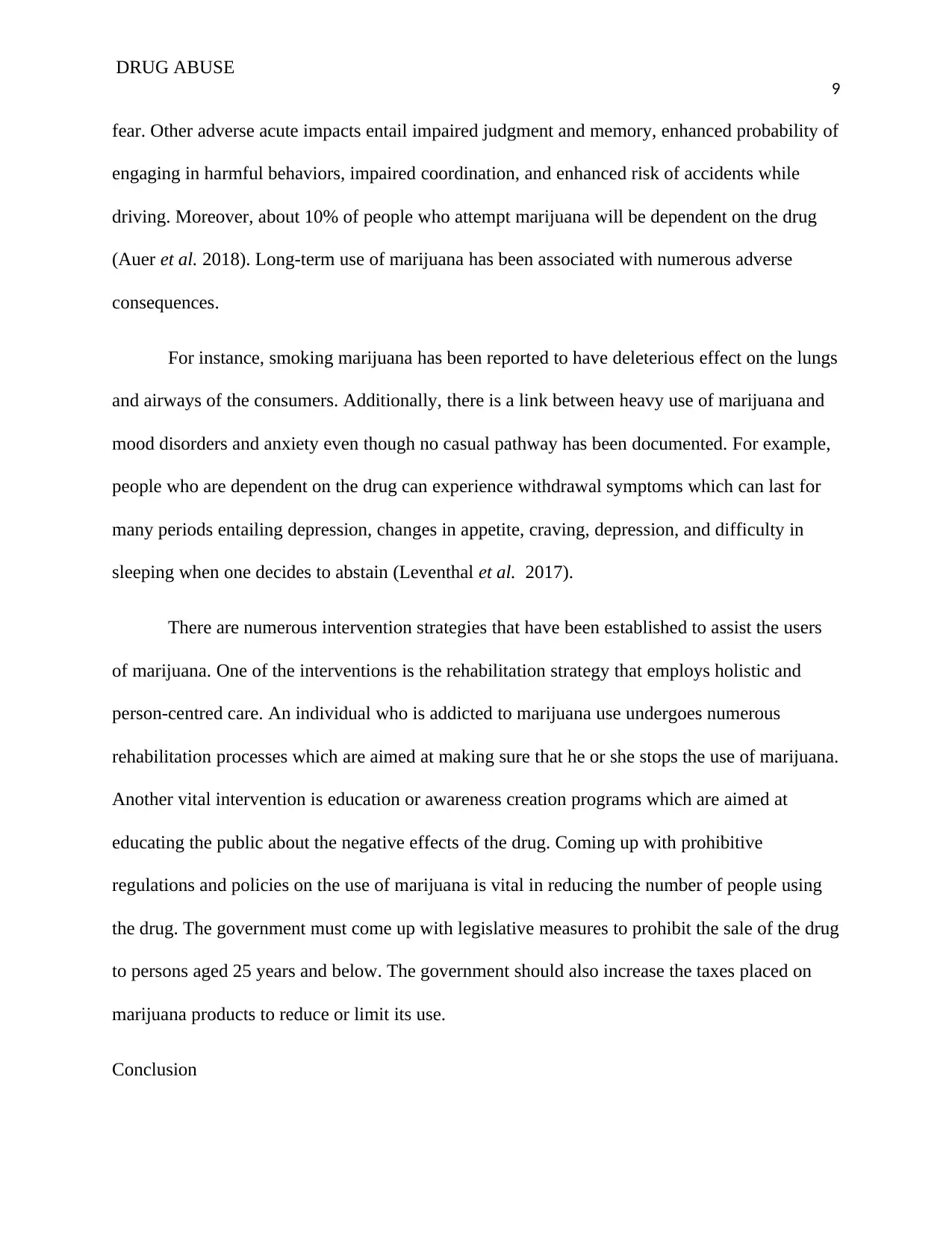
DRUG ABUSE
9
fear. Other adverse acute impacts entail impaired judgment and memory, enhanced probability of
engaging in harmful behaviors, impaired coordination, and enhanced risk of accidents while
driving. Moreover, about 10% of people who attempt marijuana will be dependent on the drug
(Auer et al. 2018). Long-term use of marijuana has been associated with numerous adverse
consequences.
For instance, smoking marijuana has been reported to have deleterious effect on the lungs
and airways of the consumers. Additionally, there is a link between heavy use of marijuana and
mood disorders and anxiety even though no casual pathway has been documented. For example,
people who are dependent on the drug can experience withdrawal symptoms which can last for
many periods entailing depression, changes in appetite, craving, depression, and difficulty in
sleeping when one decides to abstain (Leventhal et al. 2017).
There are numerous intervention strategies that have been established to assist the users
of marijuana. One of the interventions is the rehabilitation strategy that employs holistic and
person-centred care. An individual who is addicted to marijuana use undergoes numerous
rehabilitation processes which are aimed at making sure that he or she stops the use of marijuana.
Another vital intervention is education or awareness creation programs which are aimed at
educating the public about the negative effects of the drug. Coming up with prohibitive
regulations and policies on the use of marijuana is vital in reducing the number of people using
the drug. The government must come up with legislative measures to prohibit the sale of the drug
to persons aged 25 years and below. The government should also increase the taxes placed on
marijuana products to reduce or limit its use.
Conclusion
9
fear. Other adverse acute impacts entail impaired judgment and memory, enhanced probability of
engaging in harmful behaviors, impaired coordination, and enhanced risk of accidents while
driving. Moreover, about 10% of people who attempt marijuana will be dependent on the drug
(Auer et al. 2018). Long-term use of marijuana has been associated with numerous adverse
consequences.
For instance, smoking marijuana has been reported to have deleterious effect on the lungs
and airways of the consumers. Additionally, there is a link between heavy use of marijuana and
mood disorders and anxiety even though no casual pathway has been documented. For example,
people who are dependent on the drug can experience withdrawal symptoms which can last for
many periods entailing depression, changes in appetite, craving, depression, and difficulty in
sleeping when one decides to abstain (Leventhal et al. 2017).
There are numerous intervention strategies that have been established to assist the users
of marijuana. One of the interventions is the rehabilitation strategy that employs holistic and
person-centred care. An individual who is addicted to marijuana use undergoes numerous
rehabilitation processes which are aimed at making sure that he or she stops the use of marijuana.
Another vital intervention is education or awareness creation programs which are aimed at
educating the public about the negative effects of the drug. Coming up with prohibitive
regulations and policies on the use of marijuana is vital in reducing the number of people using
the drug. The government must come up with legislative measures to prohibit the sale of the drug
to persons aged 25 years and below. The government should also increase the taxes placed on
marijuana products to reduce or limit its use.
Conclusion
⊘ This is a preview!⊘
Do you want full access?
Subscribe today to unlock all pages.

Trusted by 1+ million students worldwide
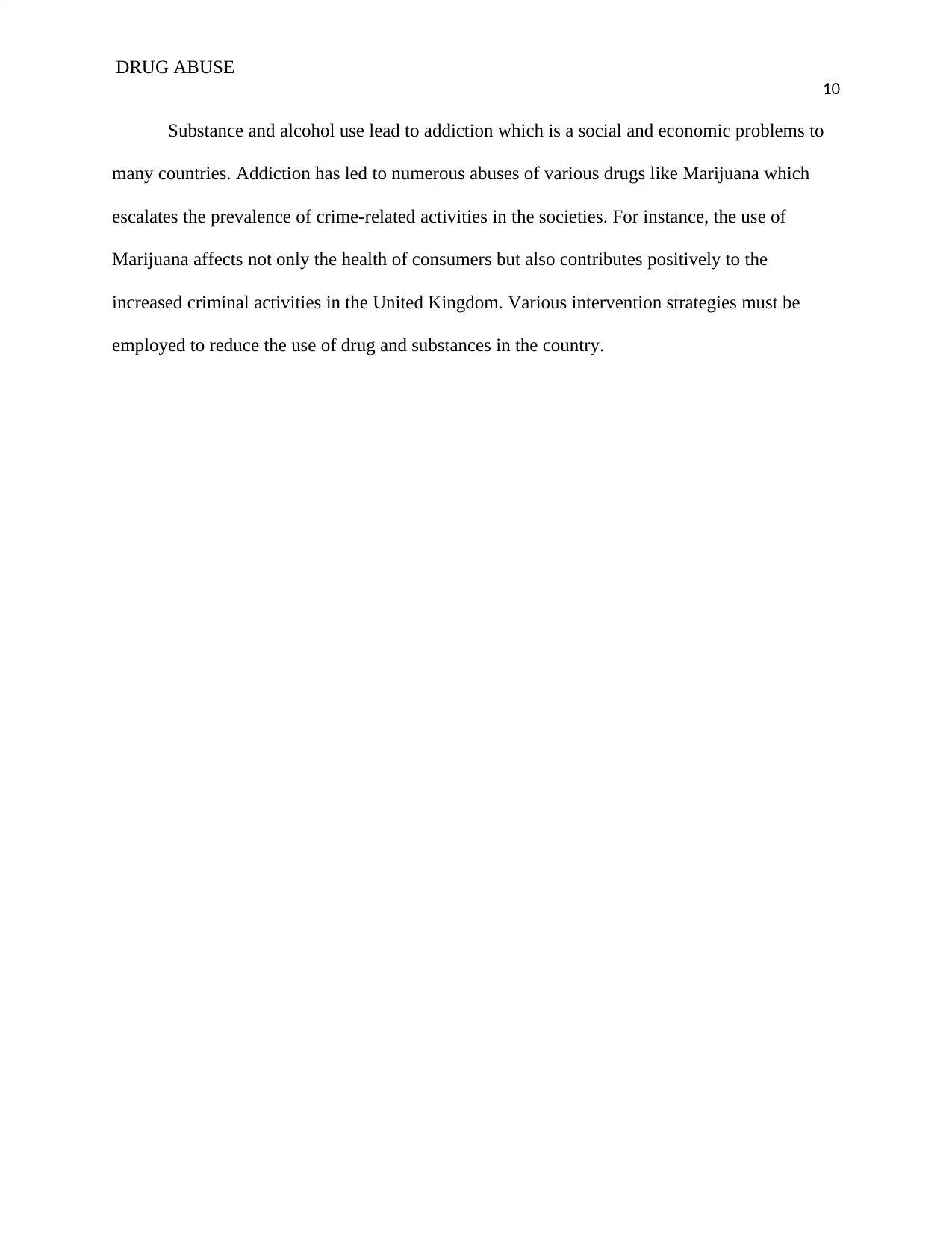
DRUG ABUSE
10
Substance and alcohol use lead to addiction which is a social and economic problems to
many countries. Addiction has led to numerous abuses of various drugs like Marijuana which
escalates the prevalence of crime-related activities in the societies. For instance, the use of
Marijuana affects not only the health of consumers but also contributes positively to the
increased criminal activities in the United Kingdom. Various intervention strategies must be
employed to reduce the use of drug and substances in the country.
10
Substance and alcohol use lead to addiction which is a social and economic problems to
many countries. Addiction has led to numerous abuses of various drugs like Marijuana which
escalates the prevalence of crime-related activities in the societies. For instance, the use of
Marijuana affects not only the health of consumers but also contributes positively to the
increased criminal activities in the United Kingdom. Various intervention strategies must be
employed to reduce the use of drug and substances in the country.
Paraphrase This Document
Need a fresh take? Get an instant paraphrase of this document with our AI Paraphraser
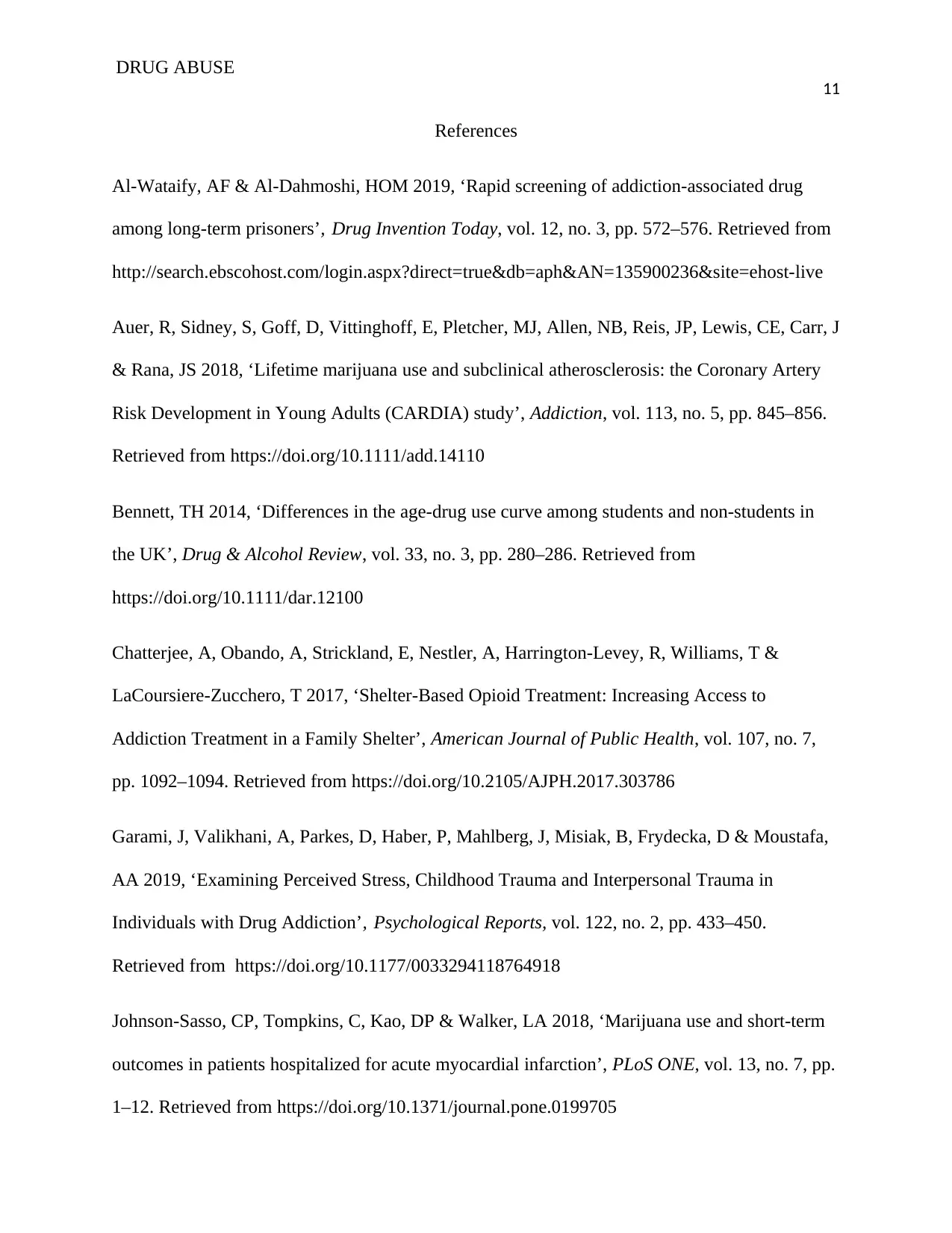
DRUG ABUSE
11
References
Al-Wataify, AF & Al-Dahmoshi, HOM 2019, ‘Rapid screening of addiction-associated drug
among long-term prisoners’, Drug Invention Today, vol. 12, no. 3, pp. 572–576. Retrieved from
http://search.ebscohost.com/login.aspx?direct=true&db=aph&AN=135900236&site=ehost-live
Auer, R, Sidney, S, Goff, D, Vittinghoff, E, Pletcher, MJ, Allen, NB, Reis, JP, Lewis, CE, Carr, J
& Rana, JS 2018, ‘Lifetime marijuana use and subclinical atherosclerosis: the Coronary Artery
Risk Development in Young Adults (CARDIA) study’, Addiction, vol. 113, no. 5, pp. 845–856.
Retrieved from https://doi.org/10.1111/add.14110
Bennett, TH 2014, ‘Differences in the age-drug use curve among students and non-students in
the UK’, Drug & Alcohol Review, vol. 33, no. 3, pp. 280–286. Retrieved from
https://doi.org/10.1111/dar.12100
Chatterjee, A, Obando, A, Strickland, E, Nestler, A, Harrington-Levey, R, Williams, T &
LaCoursiere-Zucchero, T 2017, ‘Shelter-Based Opioid Treatment: Increasing Access to
Addiction Treatment in a Family Shelter’, American Journal of Public Health, vol. 107, no. 7,
pp. 1092–1094. Retrieved from https://doi.org/10.2105/AJPH.2017.303786
Garami, J, Valikhani, A, Parkes, D, Haber, P, Mahlberg, J, Misiak, B, Frydecka, D & Moustafa,
AA 2019, ‘Examining Perceived Stress, Childhood Trauma and Interpersonal Trauma in
Individuals with Drug Addiction’, Psychological Reports, vol. 122, no. 2, pp. 433–450.
Retrieved from https://doi.org/10.1177/0033294118764918
Johnson-Sasso, CP, Tompkins, C, Kao, DP & Walker, LA 2018, ‘Marijuana use and short-term
outcomes in patients hospitalized for acute myocardial infarction’, PLoS ONE, vol. 13, no. 7, pp.
1–12. Retrieved from https://doi.org/10.1371/journal.pone.0199705
11
References
Al-Wataify, AF & Al-Dahmoshi, HOM 2019, ‘Rapid screening of addiction-associated drug
among long-term prisoners’, Drug Invention Today, vol. 12, no. 3, pp. 572–576. Retrieved from
http://search.ebscohost.com/login.aspx?direct=true&db=aph&AN=135900236&site=ehost-live
Auer, R, Sidney, S, Goff, D, Vittinghoff, E, Pletcher, MJ, Allen, NB, Reis, JP, Lewis, CE, Carr, J
& Rana, JS 2018, ‘Lifetime marijuana use and subclinical atherosclerosis: the Coronary Artery
Risk Development in Young Adults (CARDIA) study’, Addiction, vol. 113, no. 5, pp. 845–856.
Retrieved from https://doi.org/10.1111/add.14110
Bennett, TH 2014, ‘Differences in the age-drug use curve among students and non-students in
the UK’, Drug & Alcohol Review, vol. 33, no. 3, pp. 280–286. Retrieved from
https://doi.org/10.1111/dar.12100
Chatterjee, A, Obando, A, Strickland, E, Nestler, A, Harrington-Levey, R, Williams, T &
LaCoursiere-Zucchero, T 2017, ‘Shelter-Based Opioid Treatment: Increasing Access to
Addiction Treatment in a Family Shelter’, American Journal of Public Health, vol. 107, no. 7,
pp. 1092–1094. Retrieved from https://doi.org/10.2105/AJPH.2017.303786
Garami, J, Valikhani, A, Parkes, D, Haber, P, Mahlberg, J, Misiak, B, Frydecka, D & Moustafa,
AA 2019, ‘Examining Perceived Stress, Childhood Trauma and Interpersonal Trauma in
Individuals with Drug Addiction’, Psychological Reports, vol. 122, no. 2, pp. 433–450.
Retrieved from https://doi.org/10.1177/0033294118764918
Johnson-Sasso, CP, Tompkins, C, Kao, DP & Walker, LA 2018, ‘Marijuana use and short-term
outcomes in patients hospitalized for acute myocardial infarction’, PLoS ONE, vol. 13, no. 7, pp.
1–12. Retrieved from https://doi.org/10.1371/journal.pone.0199705
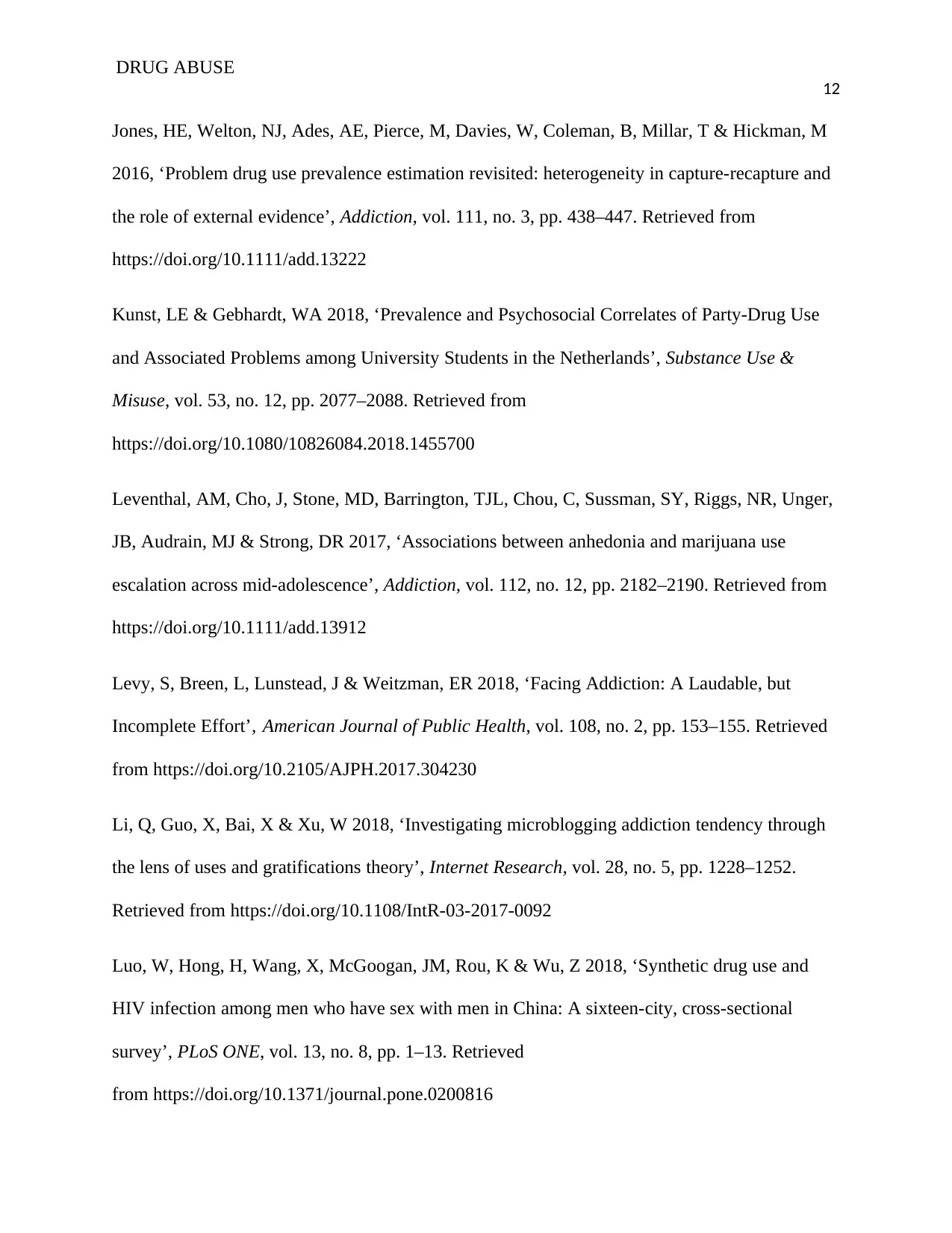
DRUG ABUSE
12
Jones, HE, Welton, NJ, Ades, AE, Pierce, M, Davies, W, Coleman, B, Millar, T & Hickman, M
2016, ‘Problem drug use prevalence estimation revisited: heterogeneity in capture-recapture and
the role of external evidence’, Addiction, vol. 111, no. 3, pp. 438–447. Retrieved from
https://doi.org/10.1111/add.13222
Kunst, LE & Gebhardt, WA 2018, ‘Prevalence and Psychosocial Correlates of Party-Drug Use
and Associated Problems among University Students in the Netherlands’, Substance Use &
Misuse, vol. 53, no. 12, pp. 2077–2088. Retrieved from
https://doi.org/10.1080/10826084.2018.1455700
Leventhal, AM, Cho, J, Stone, MD, Barrington, TJL, Chou, C, Sussman, SY, Riggs, NR, Unger,
JB, Audrain, MJ & Strong, DR 2017, ‘Associations between anhedonia and marijuana use
escalation across mid-adolescence’, Addiction, vol. 112, no. 12, pp. 2182–2190. Retrieved from
https://doi.org/10.1111/add.13912
Levy, S, Breen, L, Lunstead, J & Weitzman, ER 2018, ‘Facing Addiction: A Laudable, but
Incomplete Effort’, American Journal of Public Health, vol. 108, no. 2, pp. 153–155. Retrieved
from https://doi.org/10.2105/AJPH.2017.304230
Li, Q, Guo, X, Bai, X & Xu, W 2018, ‘Investigating microblogging addiction tendency through
the lens of uses and gratifications theory’, Internet Research, vol. 28, no. 5, pp. 1228–1252.
Retrieved from https://doi.org/10.1108/IntR-03-2017-0092
Luo, W, Hong, H, Wang, X, McGoogan, JM, Rou, K & Wu, Z 2018, ‘Synthetic drug use and
HIV infection among men who have sex with men in China: A sixteen-city, cross-sectional
survey’, PLoS ONE, vol. 13, no. 8, pp. 1–13. Retrieved
from https://doi.org/10.1371/journal.pone.0200816
12
Jones, HE, Welton, NJ, Ades, AE, Pierce, M, Davies, W, Coleman, B, Millar, T & Hickman, M
2016, ‘Problem drug use prevalence estimation revisited: heterogeneity in capture-recapture and
the role of external evidence’, Addiction, vol. 111, no. 3, pp. 438–447. Retrieved from
https://doi.org/10.1111/add.13222
Kunst, LE & Gebhardt, WA 2018, ‘Prevalence and Psychosocial Correlates of Party-Drug Use
and Associated Problems among University Students in the Netherlands’, Substance Use &
Misuse, vol. 53, no. 12, pp. 2077–2088. Retrieved from
https://doi.org/10.1080/10826084.2018.1455700
Leventhal, AM, Cho, J, Stone, MD, Barrington, TJL, Chou, C, Sussman, SY, Riggs, NR, Unger,
JB, Audrain, MJ & Strong, DR 2017, ‘Associations between anhedonia and marijuana use
escalation across mid-adolescence’, Addiction, vol. 112, no. 12, pp. 2182–2190. Retrieved from
https://doi.org/10.1111/add.13912
Levy, S, Breen, L, Lunstead, J & Weitzman, ER 2018, ‘Facing Addiction: A Laudable, but
Incomplete Effort’, American Journal of Public Health, vol. 108, no. 2, pp. 153–155. Retrieved
from https://doi.org/10.2105/AJPH.2017.304230
Li, Q, Guo, X, Bai, X & Xu, W 2018, ‘Investigating microblogging addiction tendency through
the lens of uses and gratifications theory’, Internet Research, vol. 28, no. 5, pp. 1228–1252.
Retrieved from https://doi.org/10.1108/IntR-03-2017-0092
Luo, W, Hong, H, Wang, X, McGoogan, JM, Rou, K & Wu, Z 2018, ‘Synthetic drug use and
HIV infection among men who have sex with men in China: A sixteen-city, cross-sectional
survey’, PLoS ONE, vol. 13, no. 8, pp. 1–13. Retrieved
from https://doi.org/10.1371/journal.pone.0200816
⊘ This is a preview!⊘
Do you want full access?
Subscribe today to unlock all pages.

Trusted by 1+ million students worldwide
1 out of 14
Related Documents
Your All-in-One AI-Powered Toolkit for Academic Success.
+13062052269
info@desklib.com
Available 24*7 on WhatsApp / Email
![[object Object]](/_next/static/media/star-bottom.7253800d.svg)
Unlock your academic potential
Copyright © 2020–2025 A2Z Services. All Rights Reserved. Developed and managed by ZUCOL.





